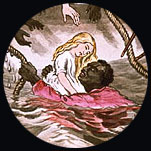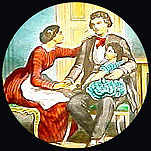

Stowe's novel was apparently translated into this medium as early as September, 1853. According to A History of the New York Stage, George Lea decided to take advantage of the record-setting popularity of Aiken's dramatization of Uncle Tom's Cabin at the National Theatre to exhibit the story in "magic lantern views" at his Franklin Museum: "many a 'country cousin' found him or herself here who thought it was Purdy's place of amusement. A brass band was stationed on the balcony to attract the stranger."*
Lea's representation organized the story into 3 parts and 25 pictures. Nothing else is known about it. The various kinds of slides available below were all made later in the century. Although undated and unsigned, they may have derived from lantern-slide formats done between 1881 and 1885 by Joseph Boggs Beale, America's leading magic lantern artist. Whoever designed them used drawings that Hammatt Billings' prepared for the Illustrated Uncle Tom's Cabin published by Jewett and Co. in late 1852, and it is interesting to note which, of the 117 scenes Billings illustrated, were chosen in order to tell Stowe's story in a dozen slides (CLICK HERE to see the Billings' illustrations).
Several different "editions" of this 12-image set are represented in the selection here, giving an idea of the range of magic lantern entertainments. The black-and-white versions you can see on this page (from two different sets) are in what was called the "Economy" format that became the standard form after 1900. They were probably sold for home use. Whenever the caption below the image appears as an active link, clicking on it will allow you to see a colored version of the same image; these range in quality from the impressive coloring and detail of Nos. 6 & 11 -- "Tom Saving Eva from Drowning" and "Legree's Cruelty to Tom" -- to the simpler No. 1 to the crudely-colored No. 5.













